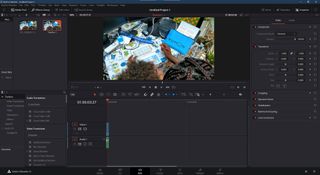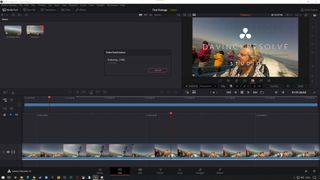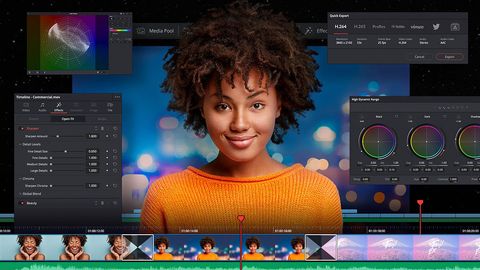Blackmagic DaVinci Resolve 17 is the latest and greatest of the video editing platforms to arrive from the studio that offers this powerful system for free. Yup, professional grade video editing software, for free
Of course you can pay for the fill DaVinci Resolve Studio, which offers more like multiple GPU support for faster renders, the ability to handle 8K video, 120fps, 3D sound, HDR delivery and a load of additional VFX. Even without all that, the free version sits high up on our list of best video editing software.
IF you're happy with 4K and 60fps editing then everything DaVinci Resolve 17 has to offer will likely serve you very well indeed. While it does has a friendly interface this is still going to require some work for a newbie to master.
DaVinci Resolve 17: Ease of Use
Every non-linear video editor suffers from a surfeit of windows, menus and options. These are, by nature, complicated applications designed to do a complicated job. Resolve is split into seven pages, and while this may seem like a lot, each one has a specific job, and you might not use all of them on a single project. Thanks to the Cut page and Quick Export, you might not need to visit the others at all.
A clever setup slideshow takes you through the features of the app, checks your home computer for compatibility, sets the storage location for your video clips, and gives you the option of matching the keyboard shortcut layout from other editing apps, including Premiere Pro.

From then on, you’re on your own. Tutorials and supporting documents aside - there are plenty online, including official documents from Blackmagic and videos from enthusiasts - this can be a difficult app to get to grips with. It is, however, extremely powerful, and will repay the time spent learning its way of doing things.
The first page on the list is the Media page, which is dedicated to importing, organizing and previewing your media clips. In a similar way to Adobe Premiere Elements’ Organizer, you can sort your clips into ‘bins’ based on metadata or keyword tags, flag them and attach notes. There’s audio syncing too. And if you need to make bit-by-bit clones of camera memory cards or SSDs, Resolve has got you covered, with backups to multiple destinations and checksum verification.
The Cut page is aimed at those working to tight deadlines, possibly on small screens on location. The interface here is tighter, the options fewer, but features such as Source Tape mode, which runs all your clips together as if they were one long tape, enabling you to scrub through the footage looking for exactly the bit you want; a dual timeline that allows you to work on one detailed area below while keeping an eye on the bigger picture above; a dedicate timeline trimming tool; and fast reviewing of your clips make things easier and faster if you’re ‘just’ knocking something together for YouTube.
For more in-depth editing the Edit page is where you can add subtitles, use effects keyframes, drag between multiple timelines, and add 2D or 3D titles. Then of course there’s all the trimming and cutting, audio overlays, multicam editing (up to 16), effects and plugins.
The Fusion page brings VFX compositing, keying, and motion graphics in a true 3D workspace. Here you can remove elements from a shot or paint them in, rotoscope moving objects, and build particle effects. Fusion is like an app on its own.

The Color page reaches back to Resolve’s history as color-correction and grading software. It adds features like Super Scale, which upscales HD to 8K, noise reduction, and can identify dust and dirt specks for removal. Its colorist tools include color wheels and curves, and there’s support for HDR grading. Color Warper alters the color and luminance of a clip at the same time while Magic Mask isolates a person's face from the rest of the clip for adjustments. Viewer Wipe Modes lets you compare shots, splitting the image diagonally to see how the changes will take effect.
Audio is handled on the Fairlight page, and that statement downplays things rather. Fairlight is a complete DAW, or digital audio workstation, and like Fusion it’s integrated into Resolve. It's also now easier to sue than ever, making it more approachable for beginners. Recording, mixing, dialog replacement, spatial audio, it’s all here. Blackmagic even sells a PCIe accelerator card ($995) just for Fairlight. The 17.1 Beta 1, launched at the time of writing, also offers support for M1 powered Mac.
Exporting can be handled by the Cut page, and the app can send videos directly to YouTube or other sites. The Delivery page, however, gives you complete control over the way your final movie is rendered. You can even output in the format used by digital theaters.
DaVinci Resolve 17: Performance
Non-linear video editors are, as we may have mentioned, complicated. The latest version of Resolve, however, attempts to simplify matters and increase the speed with which you can use it through the addition of the Cut page. Resolve 17 is quite an upgrade over previous versions, especially in terms of user-friendliness and speed of use. If you’ve been put off earlier versions of the software by its obtuse nature, then it’s worth giving the latest one a try.
In a professional setting, Resolve’s collaboration features come into their own. Project files can be held on a central server and worked on by multiple editors, artists, audio engineers, and colorists at the same time, saving time and potentially money. There’s even a chat system, and changes are tracked to show who did what, when.

DaVinci Resolve 17: Value
It’s impossible to beat Resolve in terms of value. All this, for free? Yes, really. It’s at least three applications in one, and high-end professional software, but there’s nothing stopping home users from getting in on the fun. The free version acts as an incentive to upgrade.
Blackmagic will sell you the Studio version for $299, and there are hardware aids, including a dedicated keyboard ($900) with shortcuts clearly marked and a jog wheel, all the way up to a complete studio suite for about $30,000. However, to get in on the action and start learning this industry-standard tool, there’s no cost of entry beyond a computer or laptop that can run it.
Documentation, including a comprehensive beginner’s guide, is freely available. And while it doesn’t have the step-by-step tutorials of Premiere Elements, there’s enough material available to teach yourself its workings.

Should you choose DaVinci Resolve 17?
Absolutely. What’s stopping you? It’s free. Despite a steep learning curve and a lack of built-in tutorials, Resolve is one of the most comprehensive and powerful non-linear video editing applications available today.
It’s not for absolute beginners, but if you want to say you use the same software as the people behind Gotham, Westworld, Prometheus, and The Last Jedi, there’s nothing to stop you from downloading it. Did we mention that it’s free?

